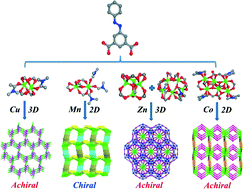Four new metal–organic frameworks based on bi-, tetra-, penta-, and hexa-nuclear clusters derived from 5-(phenyldiazenyl)isophthalic acid: syntheses, structures and properties†
Abstract
Four new metal–organic frameworks (MOFs), namely, [Cu(PDIA)(DMA)]n (JUC-126), [Mn4(PDIA)4(DMF)6]n·nDMF·2nH2O (JUC-127), [Zn23(PDIA)18(μ4-O)2(μ3-OH)6DMA6]n·10nDMA·6nH2O (JUC-128), [Co3(PDIA)2(HCOO)(μ3-OH)(H2O)(DMA)2]n·nDMA·nH2O (JUC-129) (JUC = Jilin University, China), based on a new rigid ligand 5-(phenyldiazenyl)isophthalic acid (H2PDIA) with azobenzene were synthesized under solvothermal conditions. The ligand is connected to different metals to form bi-, tetra-, penta- and hexa-nuclear cores with distinctive coordination modes to generate different structures. Moreover, π–π stacking interactions between arene cores of the ligands also exist to affect the structural assembly process. JUC-126 displays a three-dimensional (3D) NbO topology with the point symbol (64·82) based on Cu2(COO)4 as secondary building units (SBUs), JUC-127 shows a two-dimensional (2D) sql topology with the point symbol (44·62) based on Mn2(COO)4 as SBUs, JUC-128 has a new 3D topology with the point symbol (33·46·56)2(36·48·510·64)3 based on Zn4O(COO)6 and Zn5(μ3-OH)2(COO)8 as SBUs and JUC-129 exhibits a 2D sql topology with the point symbol (44·62) based on Co6(μ3-OH)2(COO)10 as SBUs. In addition, JUC-126, JUC-128 and JUC-129 are achiral frameworks; however, JUC-127 shows a chiral framework from an achiral ligand. Furthermore, the luminescent property of JUC-128 and the magnetic properties of JUC-127 and JUC-129 have been studied and discussed.


 Please wait while we load your content...
Please wait while we load your content...